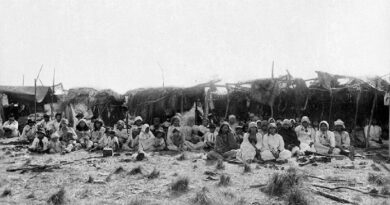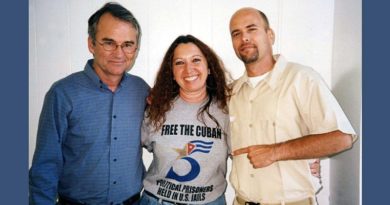El legado de apoyo de Pastores por la Paz a Cuba continúa
Por Alejandra García y Bill Hackwell.
Por Trigésima segunda ocasión en 30 años, una caravana de Pastores por la Paz arribó a Cuba con cerca de 100 personas, muchos de ellos jóvenes que están conociendo la realidad de Cuba por primera vez; viéndola por sí mismos en lugar de a través del filtro de mentiras y odio que predomina en los principales medios de comunicación estadounidenses.
La delegación no sólo está formada por personas que apoyan a Cuba por primera vez, sino también por veteranos de muchas de las caravanas de amistad lideradas por el reverendo Lucius Walker, que dedicaron años a la recogida de ayuda material esencial para la isla en ciudades y pueblos de todo Estados Unidos.
Además de las toneladas de ayuda que recopilaron, lo más importante para Pastores era explicar la verdad sobre Cuba y divulgar cómo esa isla pequeña del Caribe era ejemplo de cómo un mundo mejor es posible. El mensaje de amor de las caravanas y de Walker desafiaba la crueldad del bloqueo.
En más de una ocasión dijo que, “nuestro gobierno no tiene autoridad para decirnos quiénes son nuestros amigos. El pueblo cubano es nuestro hermano”.
Hoy en Cuba están muchos veteranos que llevan consigo la historia de estos 30 años de ayuda solidaria. Está Lisa Valenti, quien acompañó a Lucius en 1996 en una huelga de hambre de 90 días frente al Congreso para exigir la liberación de los ordenadores con destino a Cuba confiscados en la frontera mexicana por agentes estadounidenses.
Está el veterano conductor del Pastor’s Bus, Bill Hill, quien ha participado en la mayoría de las caravanas, incluyendo muchas que fueron detenidas en la frontera con México.
Estuvo desde la primera caravana de 1992, cuando los agentes fronterizos confiscaron biblias y bicicletas de manos de sacerdotes y estudiantes, hasta una caravana detenida en la frontera canadiense y cuya ayuda fue llevada desafiantemente por los caravanistas caja por caja hasta el otro lado.
Otras caravanas han desafiado la prohibición de Estados Unidos de enviar tecnología a Cuba que contenga más de un 10 por ciento de componentes fabricados en Estados Unidos, incluyendo antenas parabólicas y paneles solares.
En 1993, durante la segunda caravana, un pequeño autobús escolar amarillo fue incautado por funcionarios del Tesoro y confiscado durante 23 días, con 13 caravanistas (incluida Lisa Valenti) en su interior, en la ciudad fronteriza de Hidalgo, bajo un calor abrasador. Permanecieron bajo esas condiciones hasta que una protesta internacional obligó a su liberación. El Departamento de Estado alegó que el pequeño autobús amarillo podía ser utilizado por los “militares de la dictadura”, cuando en realidad estaba destinado a una escuela cubana para niños discapacitados.
En la historia de las caravanas siempre parecía haber una nueva forma, cada vez más ingeniosa y valiente, de romper el bloqueo.
Para resumir la determinación de estos viajes de solidaridad y amor, Bill Hill recordó lo que dijo una vez Lucio: “Estos camiones y autobuses no tienen marcha atrás. Tiene un solo propósito: avanzar hacia Cuba”.
El compromiso de Pastores por la Paz con el fin del bloqueo no se centró solo en sus propios proyectos, sino que siempre se ha extendido a otros grupos de solidaridad con Cuba en Estados Unidos cuando se ha necesitado su apoyo. En 2011, por ejemplo, cuando el Comité Internacional por la Libertad de los Cinco Héroes estaba organizando una gira del afamado grupo nacional de teatro infantil de Cuba, La Colmenita, en los Estados Unidos, hubo necesidad de un autobús para transportar a los niños entre las ciudades de la costa este, y fueron los Pastores quienes proporcionaron uno y Bill Hill lo condujo.
Cheryl LaBash, copresidenta de la Red Nacional sobre Cuba, también forma parte de esta caravana y explicó a Resumen Latinoamericano por qué Pastores por la Paz decidió iniciar las caravanas de amistad durante los años más difíciles de la Revolución, en los años 90, cuando la isla atravesaba su peor crisis económica hasta entonces, conocida como el Período Especial.
“Nuestras iniciativas se llevaron a cabo mientras la administración del entonces presidente George Bush (padre) creaba todo tipo de medidas para obstaculizar los esfuerzos de Cuba por superar la crisis. Bush había decidido mantener los fundamentos de la política genocida contra Cuba, implementada poco después del triunfo de la Revolución de 1959”.
El 6 de abril de 1960 Lester D. Mallory, Subsecretario de Estado para Asuntos Interamericanos, en un memorándum secreto del Departamento de Estado, definió así la estrategia de Estados Unidos que continúa hasta hoy: “La mayoría de los cubanos apoyan a Castro… la única manera previsible de restarle apoyo interno es mediante el desencanto y la insatisfacción derivados del malestar económico y las dificultades materiales… deben emplearse rápidamente todos los medios posibles para debilitar la vida económica de Cuba… un curso de acción que, siendo tan hábil y discreto como sea posible, logre los mayores avances para privar a Cuba de dinero y suministros, para reducir sus recursos financieros, para provocar el hambre, la desesperación y el derrocamiento del Gobierno”.
Eso prescribía lo más subrepticiamente posible para crear dificultades sin los principales socios comerciales del bloque oriental y la Unión Soviética. Y el movimiento progresista necesitaba urgentemente hacer algo desde los Estados Unidos.
¿Por qué? “Porque Cuba y la Revolución Cubana fueron un símbolo de resistencia en nuestro hemisferio, de construcción de un nuevo orden social basado en las necesidades humanas, no en el lucro. Por eso, en mi opinión, se organizaron y emprendieron las primeras caravanas”, dijo LaBash.
Y concluyó: “Cuba nunca estuvo sola y nunca lo estará. Los Pastores por la Paz y la nueva generación de caravanistas continuarán durante el tiempo que sea necesario el legado de Lucius Walker y de los cientos de caravanistas que les han precedido, para poner este criminal bloqueo a Cuba en el basurero de la historia”
Fuente: Resumen Latinoamericano – Inglés.
……….
The Legacy of Pastors for Peace Support for Cuba Continues
By Alejandra Garcia and Bill Hackwell on July 24, 2022
For the 32nd time in 30 years a Pastors for Peace caravan is in Cuba bringing close to 100 people including many young people who are experiencing the reality of Cuba for the first time; seeing for themselves instead of through the filter of lies and hate so prevalent in the main stream media of the US.
But the delegation is not just made up of first time supporters but veterans of many of the friendshipment caravans too who accompanied Pastor’s visionary leader the Reverend Lucius Walker through all those years of collecting essential material aid for the island in cities and towns all around the US. While tons of aid was delivered it was the explaining the truth about Cuba and its example of what a better world could look like along the way was what was most important. Walker’s message was one of defiance against the cruelty of the blockade, wrapped in love. He said more than once, “our government has no authority to tell us who our friends are. The Cuban people are our brothers and sisters.”
The history of the caravans is being carried in the stories of these veterans like Lisa Valenti who accompanied Lucius in 1996 on a 90 day hunger strike in front of Congress to demand the release of Cuba bound computers confiscated at the Mexican border by US agents.
Longtime Pastor’s Bus driver Bill Hill is another one who has participated in most of the caravans including many stopped at the border with furious resistance. From the first caravan in 1992 when border agents seized bibles and bicycles from the hands of priests and students to a caravan stopped at the Canadian border and the aid was then defiantly carried by caravanistas box by box to the other side. Other caravans have defied the US ban on sending technology to Cuba containing any more than 10% of US made components in it including satellite dishes and solar panels. In 1993, during the second caravan, a little yellow school bus was seized by Treasury officials and impounded for 23 days, with 13 caravanistas (including Lisa Valenti) inside, at the border town of Hidalgo in blistering heat until an international outcry forced its release. The State Department claimed the little yellow bus could be used for the military when in fact it was meant for a Cuban school for children with disabilities.
In the history of the caravans there always seemed to be another way to break the blockade.
To sum up the determination of these trips of solidarity and love Bill Hill remembered what Lucius once said, “These trucks and buses don’t have a reverse, they only go forward to Cuba.”
Pastors for Peace’s commitment to ending the blockade didn’t just focus on their own projects but it has always extended to other Cuban solidarity groups in the US when their support was needed. In 2011, for example, when the International Committee for the Freedom of the Cuban 5 was organizing a tour of the famed Cuban National Children’s Theater Group; La Colmenita in the US, there was a need for a bus to transport the children between cities on the East coast and it was Pastors who provided one and Bill Hill drove it.
Cheryl LaBash, co chair of the National Network on Cuba, is also on this caravan and explained to Resumen Latinoamericano why Pastor for Peace decided to launch the friendshipment caravans during the most difficult years of the Revolution.
“At that time it was the 1990s, and the island was going through its worst economic crisis up to that time, known as the Special Period.
Our initiatives were carried out while the administration of then President George Bush (Sr.) was creating all kinds of measures to hinder Cuba’s efforts to overcome the crisis. Bush had decided to maintain the fundamentals of the genocidal policy against Cuba, implemented shortly after the triumph of the Revolution of 1959.
On April 6, 1960 Lester D. Mallory, Deputy Assistant Secretary of State for Inter-American Affairs, in a secret State Department memo defined the US strategy that continues to this day:
“The majority of Cubans support Castro…the only foreseeable way to detract from his domestic support is by disenchantment and dissatisfaction arising from economic malaise and material hardship…every possible means must be rapidly employed to weaken the economic life of Cuba…a course of action which, being as skillful and discreet as possible, will achieve the greatest advances in depriving Cuba of money and supplies, to reduce its financial resources, to bring about hunger, despair, and the overthrow of the Government.”
That prescribed as surreptitiously as possible to create difficulties without the major trading partners of the Eastern bloc and the Soviet Union. And the progressive movement urgently needed to do something from the United States.
Why? Because Cuba and the Cuban Revolution were a symbol of resistance right here in our hemisphere, of constructing a new social order based on human needs, not on profit. So that’s why the in my opinion, the 1st Caravans were organized and undertaken.”
LaBash concluded, “Cuba was never alone and never will be. Pastors for Peace and the new generation of caravanistas will continue the legacy of Lucius Walker and the hundreds of caravanistas who have preceded them for as long as it takes to put this criminal blockade of Cuba into the dustbin of history”
Source: Resumen Latinoamericano – English




